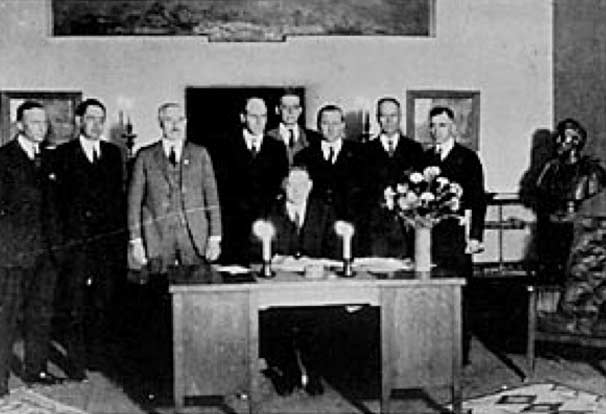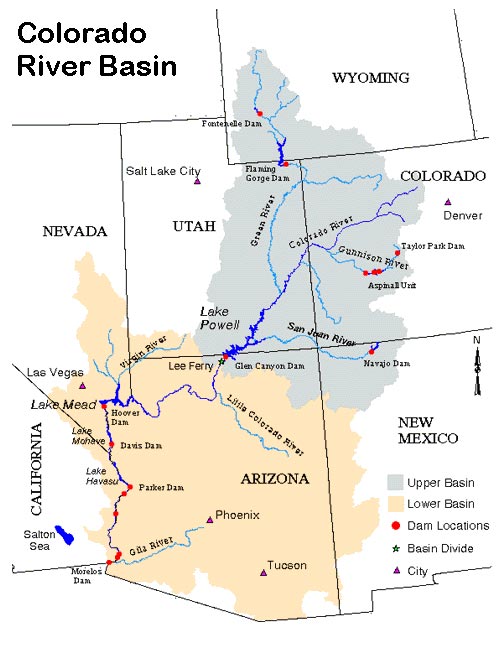
Commerce Secretary Herbert Hoover presides over the signing of the Colorado River Compact, Bishop's Lodge, outside Santa Fe, New Mexico, November 1922. Most of the water in Lakes Mead and Lakes Mohave originates hundreds of miles away. Knowing this can contribute to our understanding of how the water is and has been managed for more than a hundred years. More than 40 million people depend on the water in the Colorado River. Seven states, two countries, 5.5 million acres of farmland, 22 Native American tribes and 11 national parks all share the water, making the Colorado River one of the most intensively managed watersheds in the country. Successfully managing such an important water source is a complicated endeavor that began more than a century ago. The Colorado River basin is made up of parts of California, Arizona, Nevada, Utah, Wyoming, New Mexico, Colorado, and northern Mexico. During the early 1900’s, lower basin states were experiencing rapid development, resulting in growing demands for water. This progress threatened slower-developing northern states that were worried about their future rights to water. The threat was intensified by states such as Arizona and California requesting federal support for the construction of dams and other flood control structures to protect valuable croplands. The need for a water treaty between states was imminent and resulted in the unprecedented Colorado River Compact of 1922. This Compact endeavored to ensure everyone’s fair share of the river and would be the first in many treaties, agreements, laws and court decisions collectively known as the “law of the river.”  After more than a year of negotiations, the Compact ultimately divided the river water-use in half, allotting equal water rights to states in the upper and lower basins and reserving water for Mexico to be negotiated as part of a later treaty. At the time, negotiators believed that with equal division of the river, northern states could develop at their own pace without sacrificing water rights, while southern states could continue their rapid development with the security of what was assumed to be a sustainable water source. The two basins would negotiate individual state allotments based on a variety of factors including size, population and projections for the future. Colorado River AllocationsPolitical Entity Annual Allocation Upper Basin States 7,500,000 Colorado 3,900,000 New Mexico 800,000 Utah 1.700,000 Wyoming 1,000,000 Lower Basin States 7,500,000 California 4.400,000 Arizona 2.800,000 Nevada 300,000 Mexico 1,500,000 Total 16,500,000† †The data used in 1922 to determine the amount of water available in the river is now known to be overestimated. The original data was based on two of the wettest decades in 500 years. Until recently, this overestimation was of no issue, since many states were not using their entire allotment. However, increasing population and more than a decade of drought have made this issue a real concern. Paleontological research which examines centuries of growth patterns in organisms in the Colorado River to indicate average annual river flow now indicates the average annual flow is closer to 12.5 million acre foot (maf) per year rather than the original estimation of 16.5 maf. Data from Bureau of Reclamation The original Colorado River Compact set the stage for dozens of future negotiations that continue today. The challenges that faced states in 1922 are certainly different than the challenges we are faced with now, but the goal is the same: supplying enough safe, clean, quality water to go around. Understanding the history of management on the Colorado River sheds light on the various perspectives involved. Critical Thinking
|
Last updated: April 4, 2017
